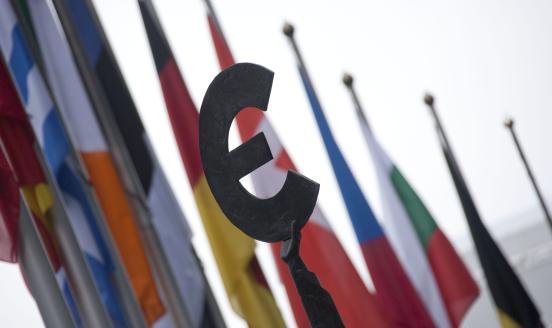The Eurozone’s gamble
For the third year in a row, the Eurozone is the weak spot of the world economy and the focus of international attention. In 2010 discussions concentrated on responses to the crisis in the periphery –Greece, Portugal and Ireland. In 2011 the crisis moved to the core as Italy and Spain felt the heat, and there were mounting concerns about the viability of the Eurozone. The question for 2012 is whether tensions are going to abate or reach a new climax.
In the eyes of many, the Greek crisis still epitomises Europe’s failings. The Europeans should indeed take the blame for their delayed, hesitant and often contradictory handling of it. In the coming weeks, hard decisions will again have to be made about debt restructuring and the provision of further assistance. Once again, the Europeans will have to accept that the situation is more serious than they thought and they will agonise over choices between alternative evils. Once again, the handling of the Greek crisis will be of significant consequences for the rest of the Eurozone. And the situation could even get worse in the months to come. But the depth of its woes should not hide that Greece is a very small economy and in many respects an extreme, special case. No other country flouted the rules the way it did and has accumulated so much public debt, and no other country combines to the same extent a dysfunctional state and an uncompetitive private economy.
The really significant battle is being fought in Spain and Italy. Those are two large economies accounting respectively for 11% and 17% of the GDP of the Eurozone. Both have seen their borrowing conditions deteriorate in the second half of 2011. Both as so large that taking them out of the market and financing them through multilateral assistance would strain, if not exhaust, the resources of the Eurozone and the IMF. Both have recently changed government and have put in place a new, reform-minded team. Both are struggling to rebuild competitiveness, foster growth, restore public finance soundness and clean up bank balance sheets. If they succeed the euro will survive. If they fail it won’t, at least in its present form.
Implicitly at least, discussions over the last few months have largely been about how to support adjustment and reform in Spain and Italy. Proposals to let the European Central Bank intervene more decisively on the bond markets, or to increase the size of the ‘firewall’ through leveraging the European financial facility, were intended to set an upper limit to interest rates paid by Spain and Italy on their debt issuance. Similarly, proposals to create common bonds were intended to quell expectations of insolvency through ensuring that these countries will eventually be able to borrow with the guarantee of their partners. All the discussions were couched in general terms but everybody had the same specific countries in mind.
It is now likely that none of these proposals will be implemented in the months to come. The ECB has bought some Italian and Spanish bonds and it may buy more, but has made clear that it is not ready to commit to a ceiling for long-term interest rates. The size of the financial facility (the EFSF) will be increased through bringing forward the creation of the permanent European Stability Mechanism (ESM) and by letting it overlap with the EFSF, but its capacity will remain limited at about €500bn, clearly below the trillion-plus envisaged by the advocates of the bazooka solution. And Eurobonds are officially off the agenda, at least for the time being. Rather, Europe is putting in place a new fiscal compact to ensure that all countries in the Eurozone implement stringent budgetary adjustments.
A reason for these choices is that all the financial engineering schemes imagined to protect Spain and Italy from aggravated borrowing conditions raise legal, political or governance difficulties. But there is also a deeper logic behind their rejection: it is thought that protection from market pressure would only slow down adjustment and reform. The perception in Northern Europe, especially in Berlin, is that only serious strains provide the required incentives to overcome domestic political and social obstacles to slashing public spending and reforming labour markets. The view is that in order for Southern Europe to take action, it needs to feel the pain. A deep recession and a sharp increase in unemployment may well be the price to pay for lasting improvements.
This reasoning is not without justification. Soon after the ECB started buying Italian bonds last august, the coalition of then-Prime minister Silvio Berlusconi backtracked on its commitments to tax reform. Even though its stance was later reversed, the episode was widely regarded as prima facie evidence of the moral hazard effect of ECB support. It took a worsening of the situation of the bond market for the coalition to fall and for Berlusconi to be replaced by the reform-minded Mario Monti.
But the strategy is also a high-risk gamble. Governments may need incentives to act, but they also need to be able to show their citizens that reform pay off. If after a few quarters of fiscal adjustment and painful reform output is lower, unemployment higher, and the outlook darker than before governments may soon lose the support of the population and reform may stall, as we have seen in Greece. Reform-minded teams may lose power to populist ones. Furthermore, a deteriorated macroeconomic and financial environment increases risks of bank failures, with immediate consequences for public finances and economic confidence. These risks are compounded by the simultaneity of such adjustments in several countries. True, competition for performance is an incentive to act. But macroeconomic and financial interdependence is also at work and it may render success more elusive.
Europe has therefore made a choice, but it has also embarked on a risky strategy. Because one thing is to consider that governments only act under pressure and that societies only accept reforms if they perceive them as without alternative, and another is to hope that adjustment and reform will proceed if the whole of Southern Europe is struggling with recession. The strategy of keeping Southern Europe on a short leash would be much more credible if accompanied by a growth programme for the Eurozone as a whole. Such a programme remains to be designed.
A version of this column was also published in Century Weekly.



